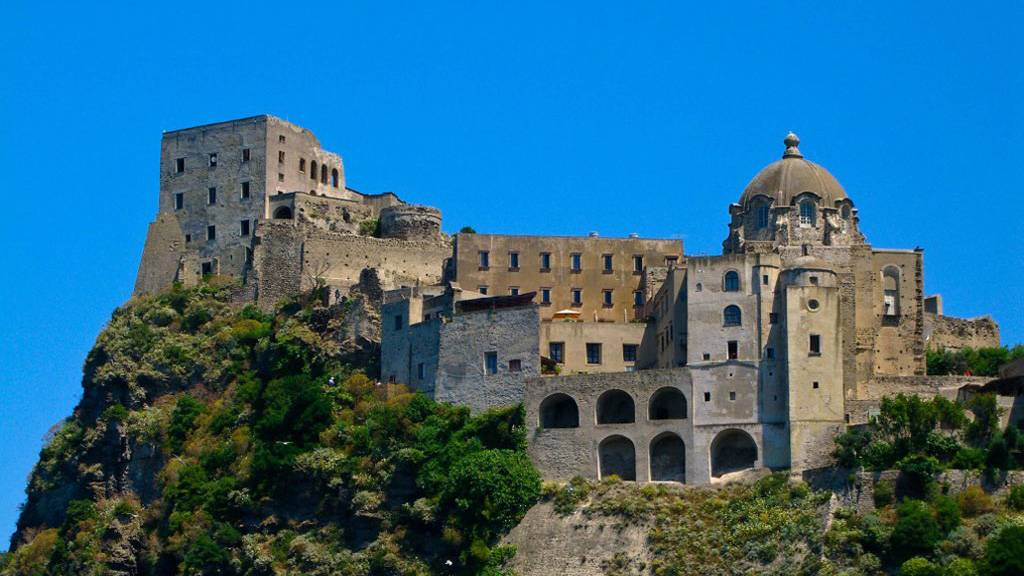The Aragonese Castle stands on an islet of trachytic rock connected to the eastern side of the island of Ischia by a 220 m long masonry bridge.
Castello Aragonese
The Aragonese Castle stands on an islet of trachytic rock connected to the eastern side of the island of Ischia by a 220 m long masonry bridge.
The rocky base is geologically defined as a "stagnation dome" and is equivalent to a bubble of magma consolidated during more far-reaching eruptive phenomena. It reaches a height of 113 meters. above sea level and has an area of approximately 56,000 m2.
It is accessed via a mule track or by means of a modern lift installed in the late 1970s.
The mule track develops, for the first stretch, in a tunnel dug into the rock (by the will of Alfonso I of Aragon in the mid-fifteenth century) and then continues in the open until it reaches the highest part where the Male is located.
From this main road branch off other minor ones that serve the buildings and gardens of the fortress. The lift instead reaches 60 meters above sea level and its path is entirely obtained inside the living rock.
The building covers a modest part of the total area mostly occupied by ruins and cultivated land; what was the densely built physiognomy portrayed by the eighteenth-century iconography was largely erased by the war events of the early nineteenth century, which were followed by long years of abandonment. Only at the beginning of the twentieth century did a systematic restoration campaign, still in progress, begin which has restored and continues to restore an architectural dignity to this imposing monumental complex.
Indisputably dominant in the image of the Castle are the silhouettes of the royal residence, called Male (which cannot be visited), and placed on the highest point of the north-eastern slope, and of the dome of the Church of the Immaculate Conception, central counterpoint of the whole islet .
Effective mediation between the rocky ridges and the built-up part is the ramparts that wrap around the Castle for 3/4 of its perimeter, strongly characterizing the whole.
Story
The first fortress was built in 474 BC. from Syracusan Greek Hieron I, who came to the aid of the Cumans in the war against the Tyrrhenian Sea. Among other things, high towers were erected to monitor the movement of enemy ships. After the war, Hiero held the island. It was then occupied by the Partenopei. In 326 B.C. the Romans took possession of it and then again the Partenopei. The looting and the long dominations of the Visigoths, Vandals, Ostrogoths, Arabs, Normans, Swabians, Angevins completely transformed the fortress of Gerone. In 1301 the last eruption of Epomeo destroyed the city Geronda, which stood where the pine forest now grows: people took refuge on the islet. In 1441 Alfonso of Aragon rebuilt the old Angevin Castle, joined the islet to the main island with an artificial bridge and had massive walls and fortifications built, within which almost all the people of Ischia found refuge and protection against the incursions of the pirates.Towards the early 1700s the fortress housed 1892 families, as well as the Convent of the Poor Clares, the Abbey of the Brazilians of Greece, the Bishop with the Chapter and the Seminary, the Prince with the garrison. There were 13 churches, of which 7 were parishes. Around 1750, once the danger from pirates had ceased, people sought more comfortable abodes in the various towns of the island of Ischia. In 1809 the British besieged the fortress, held by the French, and shelled it until it was almost completely destroyed. In 1823 the King of Naples expelled the last 30 inhabitants and reduced the Castle to a place of punishment. In 1851 he used it as a political prison. Subsequently it became a forced residence.
The Castle is open every day from 9:00 to 19:30 Entrance ticket € 10,00
Via Pontile Aragonese
Ischia Ponte
Tel 081992834/081992330
www.castelloaragonese.it



